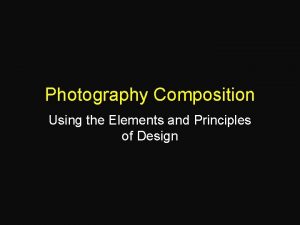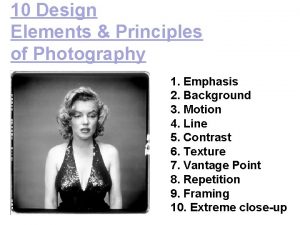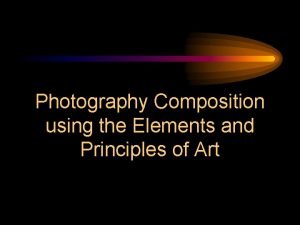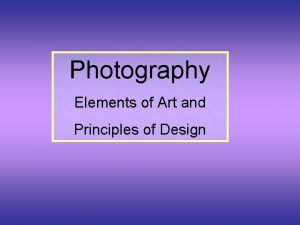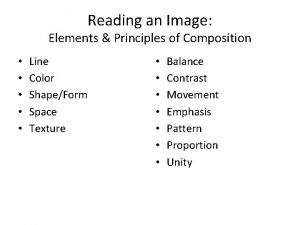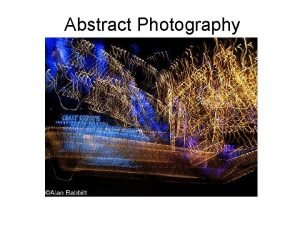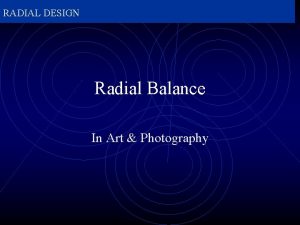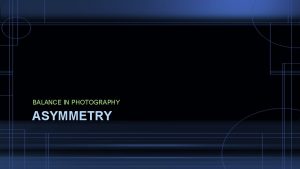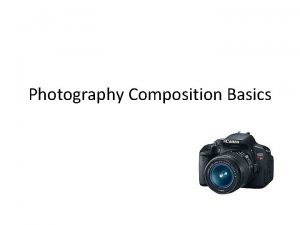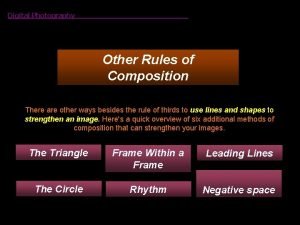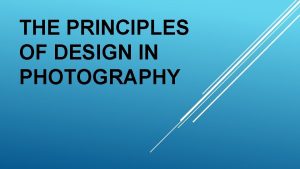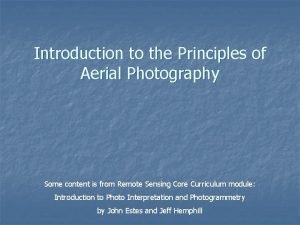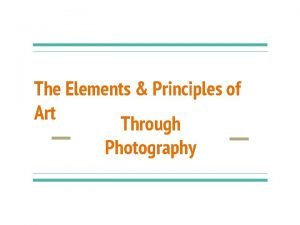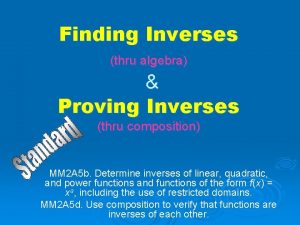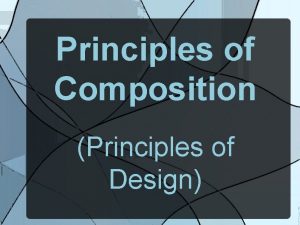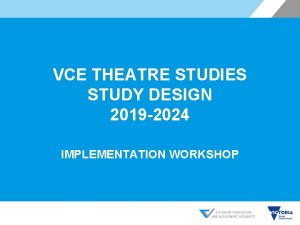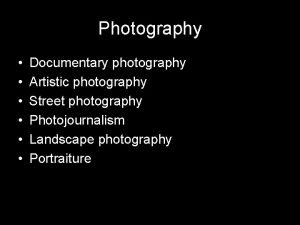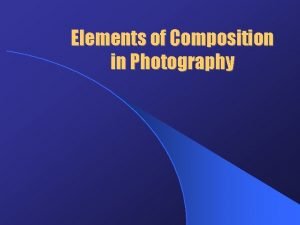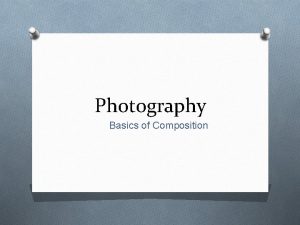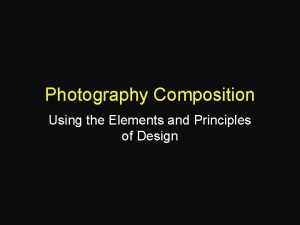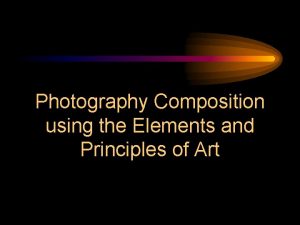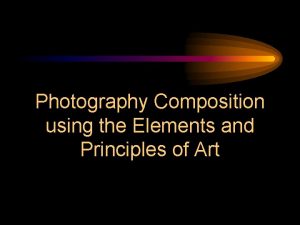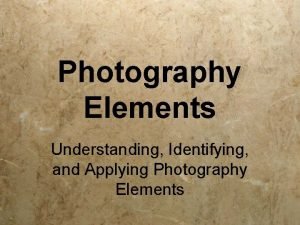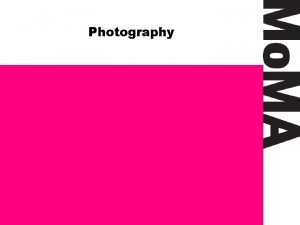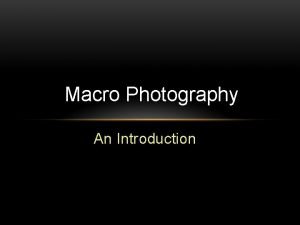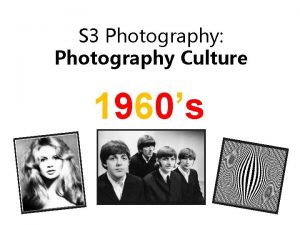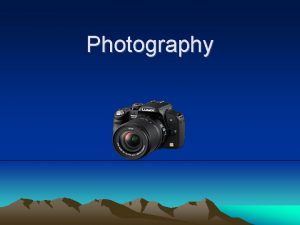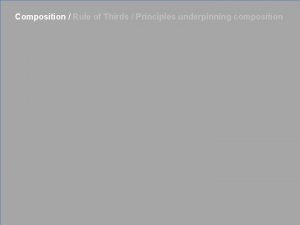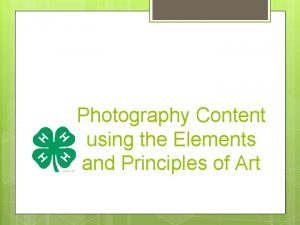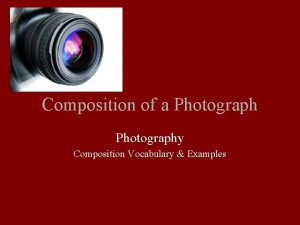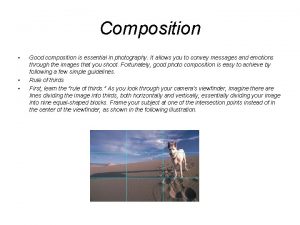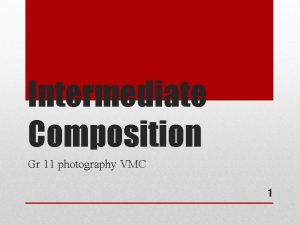Photography Composition using the Elements and Principles of






























- Slides: 30

Photography Composition using the Elements and Principles of Art

Elements The basic building blocks • • • Line Shape/Form Space Value Texture Color

Lines • A mark made by a moving point. • Has greater length than width. • Directs the eye – horizontal, vertical, diagonal, curvy, zig-zag, etc. • Can be actual obvious lines or the borders or edges of shapes.

Lines

Shape/Form • A contained area. • Can be GEOMETRIC (man-made) ex. Square, triangle, circle, etc. • Can be ORGANIC (natural) ex. Leaves, humans, puddles, etc. • Shapes are 2 -Dimensional and flat. (circle) • Forms are 3 -Dimensional with height, width and depth. (sphere) • Used to create a sense of space and substance.

Shape/Form

Space • The area used or unused in a composition. • Positive space – the area the objects/subject takes up. • Negative space – the area around, under, through and between. • Gives the photo a 3 -dimensional feeling. (Depth) • Foreground (closest), Middle ground, and Background (farthest). • Can be open, crowded, near, far, etc.

Space

Value • Black and White and all the Grays in between • Dark to Light • Can add drama and impact to composition. • Can give a sense of timelessness • Train your eye to read color as Black and White!

Value

Texture • The surface quality. • How an object feels, or how it looks like it feels. • Rough, smooth, bumpy, gooey, sharp, etc. • Adds interest! Sense of sight and sense of touch involved.

Texture

Color • • Artistic term is HUE Need light to see color. Primary, Secondary, Intermediates. Use color schemes to enhance appeal or make impact.

Color

Principles • The different arrangements – or compositions - of the ELEMENTS of design to create artistic, interesting, more visually powerful photographs. • Principles

What are the Principles of Art? • Emphasis • Balance • Unity • Contrast • Movement/ Rhythm • Pattern/Repetition

Pattern/Repetition • An element that occurs over and over again in a composition. • Can repeat the element in a consistent pattern. • Can repeat the element in a variation of the pattern.

Repetition Examples

EMPHASIS or Focal Point Emphasis in a composition refers to developing points of interest to pull the viewer's eye to important parts of the body of the work.

EMPHASIS EXAMPLES

Balance is a sense of stability in the body of work. Balance can be created by repeating same shapes and by creating a feeling of equal weight.

Balance Examples

Unity is seen in a painting or drawing when all the parts equal a whole.

Unity Examples

CONTRAST Contrast refers to the opposites and differences in the work. You can achieve variety by using different shapes, textures, colors and values in your work.

CONTRAST Examples

Movement adds excitement to your work by showing action and directing the viewers eye throughout the picture plane. Rhythm is a type of movement in drawing and painting. It is seen in repeating of shapes and colors. Alternating lights and darks also give a sense of rhythm.

Movement

The Rule of Thirds Try not to shoot anything dead Center!!! Your viewer will spend more time with your image is the objects are placed all around the center. Dead center means just that…DEAD. When the audience only has to look at the center , they spend very little time viewing and thinking about your image

Elements and Principles in Photographic Composition • The Elements and Principles are used in making photographs – not just taking photographs. • You have to know and understand the elements and principles of art to see them all around you and capture them in your photos. • Good luck!
 10 elements of photography
10 elements of photography Emphasis in photography
Emphasis in photography Unity
Unity Photography elements and principles of design
Photography elements and principles of design Elements and principles of composition
Elements and principles of composition Is abstract photography same as conceptual photography
Is abstract photography same as conceptual photography Forms of art
Forms of art Radial balance in photography
Radial balance in photography Asymmetrical balance in photography
Asymmetrical balance in photography First photograph
First photograph Which design principle involves mentally dividing
Which design principle involves mentally dividing Viewpoint composition photography
Viewpoint composition photography Diagonals and triangles photography
Diagonals and triangles photography Rhythm photography definition
Rhythm photography definition Principles of aerial photography pdf
Principles of aerial photography pdf Tone formal elements
Tone formal elements Value element of art photography
Value element of art photography Elements of art photography
Elements of art photography Proving inverse functions using composition
Proving inverse functions using composition Principles of composition
Principles of composition Theatre studies study design
Theatre studies study design Hình ảnh bộ gõ cơ thể búng tay
Hình ảnh bộ gõ cơ thể búng tay Frameset trong html5
Frameset trong html5 Bổ thể
Bổ thể Tỉ lệ cơ thể trẻ em
Tỉ lệ cơ thể trẻ em Chó sói
Chó sói Chụp tư thế worms-breton
Chụp tư thế worms-breton Chúa sống lại
Chúa sống lại Các môn thể thao bắt đầu bằng tiếng bóng
Các môn thể thao bắt đầu bằng tiếng bóng Thế nào là hệ số cao nhất
Thế nào là hệ số cao nhất Các châu lục và đại dương trên thế giới
Các châu lục và đại dương trên thế giới
